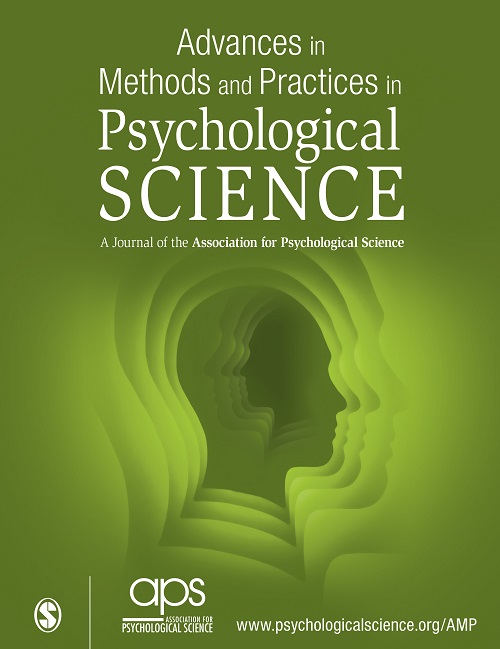关键在于时间:探索分析数字表型数据的不同时间分辨率
IF 15.6
1区 心理学
Q1 PSYCHOLOGY
Advances in Methods and Practices in Psychological Science
Pub Date : 2024-01-01
DOI:10.1177/25152459231202677
引用次数: 0
摘要
使用智能手机和可穿戴传感器被动地收集行为数据,对于更好地了解心理健康和精神障碍具有极大的潜力,而且负担最小。然而,在方法论上存在一些重要的挑战,可能会阻碍这些被动措施的广泛应用。其中一个关键问题是时间尺度:在总结和分析数据时所选择的时间分辨率可能会影响对结果的解释。尽管时间分辨率非常重要,但很少有人能证明时间分辨率的选择是合理的。在本研究中,我们旨在通过解决研究人员面临的与时间相关的决策问题,来改进当前的数字表型数据分析标准。为了说明问题,我们使用了 10 名学生的数据,通过他们手机上的 Behapp 应用程序记录了他们 28 天的行为(如 GPS、应用程序使用情况)。与此同时,参与者每天都会在手机上主动回答几次有关自己情绪的问卷。我们简要介绍了如何通过个性化相关分析和随机森林预测模型来研究不同的时间尺度。通过这种方法,我们展示了选择不同的分辨率会导致不同的结论。因此,我们建议进行多重宇宙分析,研究选择不同时间分辨率的后果。这将改善目前分析数字表型数据的标准,并有助于解决部分由于研究人员做出隐含决定而导致的复制危机。本文章由计算机程序翻译,如有差异,请以英文原文为准。
It’s All About Timing: Exploring Different Temporal Resolutions for Analyzing Digital-Phenotyping Data
The use of smartphones and wearable sensors to passively collect data on behavior has great potential for better understanding psychological well-being and mental disorders with minimal burden. However, there are important methodological challenges that may hinder the widespread adoption of these passive measures. A crucial one is the issue of timescale: The chosen temporal resolution for summarizing and analyzing the data may affect how results are interpreted. Despite its importance, the choice of temporal resolution is rarely justified. In this study, we aim to improve current standards for analyzing digital-phenotyping data by addressing the time-related decisions faced by researchers. For illustrative purposes, we use data from 10 students whose behavior (e.g., GPS, app usage) was recorded for 28 days through the Behapp application on their mobile phones. In parallel, the participants actively answered questionnaires on their phones about their mood several times a day. We provide a walk-through on how to study different timescales by doing individualized correlation analyses and random-forest prediction models. By doing so, we demonstrate how choosing different resolutions can lead to different conclusions. Therefore, we propose conducting a multiverse analysis to investigate the consequences of choosing different temporal resolutions. This will improve current standards for analyzing digital-phenotyping data and may help combat the replications crisis caused in part by researchers making implicit decisions.
求助全文
通过发布文献求助,成功后即可免费获取论文全文。
去求助
来源期刊
CiteScore
21.20
自引率
0.70%
发文量
16
期刊介绍:
In 2021, Advances in Methods and Practices in Psychological Science will undergo a transition to become an open access journal. This journal focuses on publishing innovative developments in research methods, practices, and conduct within the field of psychological science. It embraces a wide range of areas and topics and encourages the integration of methodological and analytical questions.
The aim of AMPPS is to bring the latest methodological advances to researchers from various disciplines, even those who are not methodological experts. Therefore, the journal seeks submissions that are accessible to readers with different research interests and that represent the diverse research trends within the field of psychological science.
The types of content that AMPPS welcomes include articles that communicate advancements in methods, practices, and metascience, as well as empirical scientific best practices. Additionally, tutorials, commentaries, and simulation studies on new techniques and research tools are encouraged. The journal also aims to publish papers that bring advances from specialized subfields to a broader audience. Lastly, AMPPS accepts Registered Replication Reports, which focus on replicating important findings from previously published studies.
Overall, the transition of Advances in Methods and Practices in Psychological Science to an open access journal aims to increase accessibility and promote the dissemination of new developments in research methods and practices within the field of psychological science.

 求助内容:
求助内容: 应助结果提醒方式:
应助结果提醒方式:


